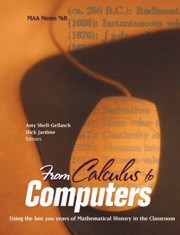Book contents
- Frontmatter
- Preface
- Contents
- Introduction
- I Algebra, Number Theory, Calculus, and Dynamical Systems
- II Geometry
- III Discrete Mathematics, Computer Science, Numerical Methods, Logic, and Statistics
- IV History of Mathematics and Pedagogy
- 16 Incorporating the Mathematical Achievements of Women and Minority Mathematicians into Classrooms
- 17 Mathematical Topics in an Undergraduate History of Science Course
- 18 Building a History of Mathematics Course from a Local Perspective
- 19 Protractors in the Classroom: An Historical Perspective
- 20 The Metric System Enters the American Classroom: 1790–1890
- 21 Some Wrinkles for a History of Mathematics Course
- 22 Teaching History of Mathematics Through Problems
- About the Authors
20 - The Metric System Enters the American Classroom: 1790–1890
from IV - History of Mathematics and Pedagogy
- Frontmatter
- Preface
- Contents
- Introduction
- I Algebra, Number Theory, Calculus, and Dynamical Systems
- II Geometry
- III Discrete Mathematics, Computer Science, Numerical Methods, Logic, and Statistics
- IV History of Mathematics and Pedagogy
- 16 Incorporating the Mathematical Achievements of Women and Minority Mathematicians into Classrooms
- 17 Mathematical Topics in an Undergraduate History of Science Course
- 18 Building a History of Mathematics Course from a Local Perspective
- 19 Protractors in the Classroom: An Historical Perspective
- 20 The Metric System Enters the American Classroom: 1790–1890
- 21 Some Wrinkles for a History of Mathematics Course
- 22 Teaching History of Mathematics Through Problems
- About the Authors
Summary
Introduction
The nineteenth century saw an enormous expansion in American mathematics education. Publicly funded elementary or common schools were established, first in the northern states and then throughout the country. By the second half of the century, public high schools also were becoming usual. The extension of engineering education, much of it modeled after the École Polytechnique in Paris, also encouraged mathematics instruction. At the same time, improvements in printing, cheaper paper, and the national markets created by railroads made it possible to supply students in the new schools with relatively inexpensive, uniform textbooks.
Several teachers and former teachers sought to supply the new schoolrooms with texts. Publishers such as A. S. Barnes & Company of Hartford and Appleton's of New York developed and marketed entire series of books [1, 18, 24]. Authors were mindful both of information included by their competitors and of requirements of school committees and newly established state boards of education. To remain competitive, many arithmetic textbooks came to include a discussion of the relatively recently formulated metric system of weights and measures. Discussions of the metric system in these books well illustrate the difficulty of making new mathematical structures part of the educational canon.
The Origins of the Metric System
In the wake of the revolution of 1789, French citizens called for uniform weights and measures throughout their country. With the approval of the National Assembly and subsequent national governments, a commission of the Paris Academy of Sciences and its successor, the Institute of France, developed totally new units for measuring distance, volume, weight, angles and even time.
- Type
- Chapter
- Information
- From Calculus to ComputersUsing the Last 200 Years of Mathematics History in the Classroom, pp. 229 - 236Publisher: Mathematical Association of AmericaPrint publication year: 2005

